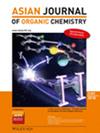Umpolung C(3)–H Functionalization of Indoles via I(III) Intermediates: Synthesis of Indol‐3‐yl Xanthates
IF 2.7
4区 化学
Q1 CHEMISTRY, ORGANIC
引用次数: 0
Abstract
Herein, we report a transition‐metal‐free strategy for the synthesis of O‐alkyl‐S‐(indol‐3‐yl) xanthates, valuable surrogates for indol‐3‐yl thiols. The method relies on the in situ formation of electrophilic (3,5‐dimethylisoxazol‐4‐yl)(indol‐3‐yl)iodonium salts via highly chemo‐ and regioselective C(3)–H functionalization of indoles with (3,5‐dimethylisoxazol‐4‐yl)–I(OH)OTs, a Koser's type reagent. These electrophilic intermediates readily react with potassium O‐alkyl xanthates, delivering the corresponding O‐alkyl‐S‐(indol‐3‐yl) xanthates in good‐to‐high yields. The protocol exhibits good functional group compatibility and is well‐suited for late‐stage functionalization of complex bioactive molecules, as demonstrated by the derivatization of the antiviral agent CCG‐203926 and estradiol, a steroid hormone. This operationally simple protocol provides an efficient approach to otherwise inaccessible indol‐3‐yl xanthates that are both a class of compounds of considerable interest due to their potential biological activity and valuable precursors for other indole derivatives containing organosulfur functional groups at the C(3) position.

通过I(III)中间体对吲哚的C(3) -H功能化:吲哚-3-基黄药的合成
在此,我们报道了一种无过渡金属的策略来合成o -烷基- s -(吲哚-3-基)黄药,这是吲哚-3-基硫醇的有价值的替代品。该方法依赖于(3,5-二甲基异恶唑-4-基)(吲哚-3-基)碘盐的原位形成,通过高度化学和区域选择性的C(3) - h功能化吲哚与(3,5-二甲基异恶唑-4-基)- i (OH)OTs,一种Koser型试剂。这些亲电中间体很容易与o-烷基黄药钾反应,产生相应的o-烷基- s -(吲哚-3-基)黄药,收率高。该方案具有良好的官能团相容性,非常适合复杂生物活性分子的后期功能化,抗病毒药物CCG-203926和甾体激素雌二醇的衍生化证明了这一点。这个操作简单的方案提供了一种有效的方法来研究吲哚-3-基黄药,这类化合物由于其潜在的生物活性而备受关注,同时也是其他含有C(3)位有机硫官能团的吲哚衍生物的有价值的前体。
本文章由计算机程序翻译,如有差异,请以英文原文为准。
求助全文
约1分钟内获得全文
求助全文
来源期刊

Asian Journal of Organic Chemistry
CHEMISTRY, ORGANIC-
CiteScore
4.70
自引率
3.70%
发文量
372
期刊介绍:
Organic chemistry is the fundamental science that stands at the heart of chemistry, biology, and materials science. Research in these areas is vigorous and truly international, with three major regions making almost equal contributions: America, Europe and Asia. Asia now has its own top international organic chemistry journal—the Asian Journal of Organic Chemistry (AsianJOC)
The AsianJOC is designed to be a top-ranked international research journal and publishes primary research as well as critical secondary information from authors across the world. The journal covers organic chemistry in its entirety. Authors and readers come from academia, the chemical industry, and government laboratories.
 求助内容:
求助内容: 应助结果提醒方式:
应助结果提醒方式:


